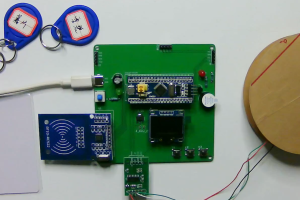设计说明书
总字数:9000+
随着消费水平的提高,大型连锁超市近年来迅猛发展。这些大型超市具有商品种类多,交易量大的特点,为了提高商场的收银效率,本系统设计基于单片机的超市收银机控制系统以超市收银为研究对象,以STM32单片机为核心控制芯片,以RFID卡、称重模块为输入,实现刷卡和称重功能,通过一个LED灯闪烁提示结账,通过OLED显示屏显示商品,价格,重量,结账信息等,通过按键切换刷卡、称重、结账界面。整个收银系统包含单片机的最小系统、称重模块、独立按键模块、RFID刷卡模块、LED灯模块、蜂鸣器提示音模块以及显示模块等组成。系统最终实现了刷卡、称重、按键提示音、结账提醒等功能。此系统不仅提高了超市的收银效率,也节约了消费者的时间,营造了良好的消费环境,提高消费者的消费体验。
关键词:STM32;超市收银;RFID;OLED
Abstract:With the improvement of consumption level, large chain supermarket has developed rapidly in recent years. These large supermarkets have the characteristics of many kinds of commodities and large trading volume. In order to improve the efficiency of the cashier in the mall, this system designs the supermarket cash register control system based on the single chip microcomputer to the supermarket cashier as the research object, STM32 single chip microcomputer as the core control chip, RFID card and weighing module as the input, to realize the card swiping and weighing functions. Through an LED light flashing prompt checkout, through the OLED display display goods, price, weight, checkout information, switch through the button swipe card, weighing, checkout interface. The whole cash register system consists of microcontroller minimum system, weighing module, independent key module, RFID card module, LED light module, buzzer sound module and display module. The system finally realized the card, weighing, key prompt tone, checkout reminder and other functions. This system not only improves the efficiency of supermarket cash register, but also saves consumers’ time, creates a good consumption environment and improves consumers’ consumption experience.
Key words: STM32; Supermarket cash register; RFID; OLED
目录
1 绪论
1.1 收银机的发展背景和现实意义
1.2 收银机国内外发展现状
1.3 设计功能实现
2 自动售货控制系统设计分析
2.1 系统总体设计分析
2.2 元器件选择
2.2.1 单片机的选择
2.2.2 按键的选择
2.2.3 显示方案的选择
3 控制系统硬件设计
3.1 单片机最小系统
图2 主控芯片原理图
3.3 RFID刷卡模块电路
3.4 称重模块电路
3.4 显示模块电路
3.5 按键模块电路
3.6 指示灯模块
3.7 提示音电路设计
4 系统程序设计
4.1 编程软件介绍
4.2 系统主流程设计
4.3 独立按键
4.4 称重模块HX711模块子流程
4.5 OLED显示流程设计
5实物调试
5.1 实物总体设计
5.2 录入商品实物测试
5.3 结账实物测试
总结
参考文献
致谢
附 录
附录1:原理图
附录3:主程序
购买后可查看具体内容!

